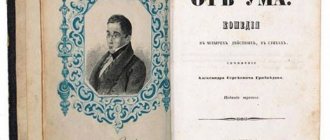Continuity of the play's traditions
The play “Woe from Wit” by A. S. Griboedov (1795-1829) reflected the traditions and experience of Russian literature accumulated at the previous stage of its development. Griboedov's merit is that he brought together, united and enriched these traditions. The emergence of the comedy “Woe from Wit” was prepared by:
✓ Fonvizin’s comedy “The Minor,” with which “Woe from Wit” has the following features in common:
• satirical character;
• protest against serfdom;
• criticism of the court nobility and nobility;
• creation of typical, widespread images and phenomena;
• realistic portrayal of characters;
• subordination of love affair to social conflict;
• realism of speech;
✓ Radishchev’s work, in particular “Journey from St. Petersburg to Moscow,” with which “Woe from Wit” is related in the description of the attitude of landowners towards their serfs and the attitude of serfs towards their masters;
✓ works by Karamzin, with which “Woe from Wit” has the following features in common:
• poeticization of old times and contempt for everything new;
• the mournful and ironic nature of the motive of an intelligent person forced to live in a world of fools;
✓ the work of Krylov, with whom “Woe from Wit” has the following features in common:
• the pathos of protecting national culture;
• criticism of everything foreign, especially in the field of education and upbringing of the younger generation;
• fable allegory, humor and vernacular language;
The originality of the composition of the comedy "Woe from Wit"
The composition of the comedy “Woe from Wit” is very specific, and it is distinguished by the following features:
✓ the confrontation between two groups of characters (the group headed by Chatsky and Famusov’s group), which determines the originality of the conflict of the play;
✓ extensive exposition in which the main character is absent (does not appear in the play immediately);
✓ the special significance of each character of the second and third plans, including off-stage ones, which will subsequently be reflected in the plays of A.N. Ostrovsky;
✓ symmetry of construction, which is manifested in the following:
• dividing four acts into two parts, where the first is dominated by love intrigue, and the second by social conflict, while both intrigues are present throughout the comedy, but one dominates the other;
• different, unequal number of phenomena in each act;
✓ many monologues, which play a large role in comedy;
✓ an important function of gossip, which binds all the plot lines of the play into one whole, and this gossip grows and develops throughout the comedy, acquiring new, sometimes contradictory, details.
Comedy genre
The comedy "Woe from Wit" has the following genre features:
✓ Griboyedov himself called it a comedy, and this was later confirmed by Pushkin;
✓ It is difficult to determine the exact genre of the play for the following reasons:
• differences in comic criteria among different researchers;
• different approaches to understanding the final insight of Chatsky and Sophia;
✓ from the point of view of specificity, it is a satirical comedy, since it contains satirical ridicule of the characters and situations covered in the comedy;
✓ is a social comedy, since it is dominated not by love, but by social conflict, reflecting the contradictions and conflict of the “present century” and the “past century”;
✓ is a high comedy (as defined by A.S. Pushkin), that is, it is based not only on laughter, but also on the development of characters;
✓ is a comedy of characters and morals, since the comedy of characters predominates in it and, to a lesser extent, the comedy of situations and situations;
✓ is a comedy in verse;
✓ contains “a peculiar combination of individual genre features of high, social satirical comedy in verse, stage poem and drama.”
Problems of the work
When analyzing, it is worth analyzing the problems of the work.
The author raised problems that still concern society:
- Dispute between generations. Griboedov tried to show how different the old nobility was from the new. He hoped that the younger generation could transform a world that was mired in cruelty and lies.
- Morals of the nobility. The writer demonstrates noble society from its worst side. The author believed that Famus society consists entirely of debauchery, lies and cruelty. The people who make up the majority of the nobility are parasites who satisfy only their base needs.
- Development of the country. Throughout the work, some characters talk about their acquaintances who do not need a social life, since they decided to devote themselves to science and art. Such a transformation in the country makes it clear that neither Famusov nor Skalozub will be able to do anything about the changes.
- Education. The author has a positive attitude towards people who are involved in education and want to discover something new. He rejects the nobility who ridicule people of science.
- Fate. The main character hoped that he could marry Sophia and live a happy life with her. However, his plans are not destined to come true.
- Love. Griboedov teaches readers that one should not blindly surrender to love. If you follow your feelings without thinking, you can repeat the mistakes of Chatsky and Sophia.
- Ideals of the Decembrists. The work presents the traditions of the Decembrists, who advocated the abolition of serfdom and the democratization of Russian society. The author ridiculed the nobles and encouraged the worldview and goals of Chatsky, who advocated progress in the country.
Artistic method of comedy
The comedy “Woe from Wit” is a unique phenomenon from the point of view of artistic method in the development of Russian literature at the beginning of the 19th century. This comedy includes features and elements of the following literary movements:
✓ classicism;
✓ romanticism;
✓ realism.
Classicism is represented in comedy by such features as:
✓ rationalistic conflict between smart and stupid, smart people and fools, education and ignorance;
✓ unity of place (Famusov’s house) and time (one day throughout the entire action of the comedy);
✓ five-act structure of the play;
✓ dividing heroes into positive and negative;
✓ “talking” surnames of characters;
✓ several schematic images with one character trait clearly highlighted (Countess Khryumina, Tugoukhovskaya).
Romanticism is represented in comedy by its following features:
✓ interpretation of the image of Chatsky, whose romanticism is manifested in the following features:
• opposition to the entire world around him;
• elation above everyday life;
• belief in the power of conviction;
• sublimity and dreaminess of nature;
• manifestation of violent temperament in behavior;
• feeling of loneliness at the end of the comedy;
✓ author's attention to the appearance of some heroes, for example Sophia and Chatsky;
✓ use of the road theme in the poem;
✓ appeal to the genre of the poem, which is reflected in the very concept of the comedy.
Artistic originality of “Woe from Wit”
Features of the creative method
In terms of the creative method, “Woe from Wit” can be defined as a realistic work with features of classicism and romanticism.
Traditions of classicism
In the era of Griboedov, classicism as a literary movement had exhausted itself. Still, the author of “Woe from Wit” followed some traditions of classicism.
Griboedov observes in his work the principles of unity of place and unity of time : the action of the comedy takes place in one place (in Famusov’s house) over the course of one day. At the same time, the author retreated from the principle of unity of action: the love affair is complicated by ideological conflict.
The author divides characters into positive and negative . Meanwhile, this principle is not observed very clearly. For example, it is difficult to unequivocally classify Sophia as a positive or negative character.
The characters are given traditional roles . Molchalin is the first lover. Chatsky is a hero-reasoner and at the same time an unlucky lover. Sophia is the bride. Famusov is the father of the bride. Skalozub claims to be the groom. Lisa is a cunning servant.
Most of the characters have telling surnames or names-characteristics: “Famusov” (“fama” means “rumor” in Latin, “Famusov” means “famous”, “famous”), “Skalozub”, “Molchalin”, “Tugoukhovskie” , “Repetilov” (from the French word “répéter” - repeat). The surname “Chatsky” reminds us of Chaadaev, a historical figure who became one of the prototypes of the main character of the comedy.
In addition, the role of monologues ; the language of “Woe from Wit” is aphoristic . Although the comedy as a whole is written in free iambic , it is dominated by Alexandrian verse (iambic hexameter with a caesura in the middle of the verse). All this also testifies to the influence of the traditions of the theater of classicism on Griboyedov.
Traits of Romanticism
The influence of romanticism on Griboyedov was less significant than the influence of classicism.
As you know, the basis of romanticism is the affirmation of the author's ideal in its opposition to reality. The high ideals of Chatsky , close to the author, are contrasted in “Woe from Wit” with the unworthy life of the Moscow nobility.
In addition, “Woe from Wit” contains such romantic motifs as loneliness, wandering, and exile. For example, Chatsky appears before us as a lonely fighter for the truth, not understood by those around him. The wandering of the protagonist, preceding the stage action, the break with society, his expulsion from society at the end of the action - all this brings him closer to romantic heroes.
"Woe from Wit" as a realistic work
In general, “Woe from Wit” is a realistic work . It is distinguished by such features of realism as historicism, typification of characters, psychologism, and living spoken language.
Thus, Griboyedov’s comedy is characterized by deep historicism : it reflects many of the realities of the era of the late 1810s - early 1820s, and most importantly, it reveals the main social conflict of that time - the confrontation between the liberal and conservative nobility.
In addition, the characters of the characters in “Woe from Wit” are far from being exhausted by their traditional roles that came from the theater of classicism. The comedy characters are bright, concrete historical types.
For example, Chatsky is interesting to us not only for his role as a hero-reasoner or an unlucky lover. This is, first of all, the type of opposition-minded young nobleman of the pre-December era. Famusov acts not only as the father of the bride, but also as a major official and at the same time a serf-owner who adheres to conservative views. Molchalin acts not only as the first lover, but also as an official-bureaucrat, whose life principles are “moderation and accuracy.” The significance of Skalozub is also not limited to the role of a potential groom. This is an Arakcheevsky officer, a type of military man characteristic of the last years of the reign of Alexander I.
In addition, the realism of the comedy is manifested in the deep psychological development of the characters’ characters, especially Chatsky and Sophia.
Finally, the realism of the work is evidenced by the richness of the characters’ language , which is as close as possible to the colloquial speech of Moscow bar and servants.
Genre originality
"Woe from Wit" is usually defined as a comedy with features of a psychological drama.
In "Woe from Wit", as in most comedies, we find a satirical depiction of social mores and negative characters.
At the same time, Griboedov's comedy also has its own specific features. “Woe from Wit” is, firstly, an everyday comedy , since here the playwright reproduces many aspects of the life of the Moscow nobility: education of youth, noble life, secular entertainment. Secondly, this is a high comedy - in accordance with the traditions of classicism. The main character, close to the author (the so-called high hero), preaches civic ideals and exposes the vices of the society around him. Finally, “Woe from Wit” is a socio-political comedy , since the conflict in the work is not only moral, but also socio-political in nature. In “Woe from Wit,” through the mouth of Chatsky, the social foundations of Famus society are exposed: serfdom, the cult of ranks and uniforms, admiration for foreign fashions. The hero proclaims the ideals of freedom, enlightenment, and national identity.
In "Woe from Wit" we also find elements of drama . As we know, the basis of drama is the conflict between the individual and society. There is a similar conflict in “Woe from Wit.” At the same time, the reader and viewer are interested not only in the confrontation between Chatsky and Famusov’s society, but also in the personal experiences of the hero, his “millions of torments”: the hero experiences both unhappy love and universal hatred directed at him. Therefore, “Woe from Wit” has the features of a psychological drama. Griboyedov shows the inner world not only Chatsky , but also Sophia : the playwright conveys the growing hostility of the heroine towards Chatsky, her mental turmoil at the moment of Molchalin’s exposure.
Features of the composition



